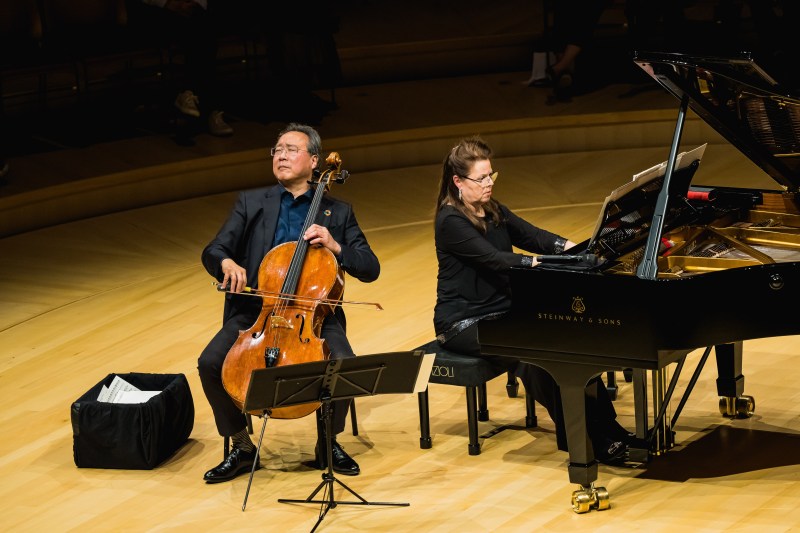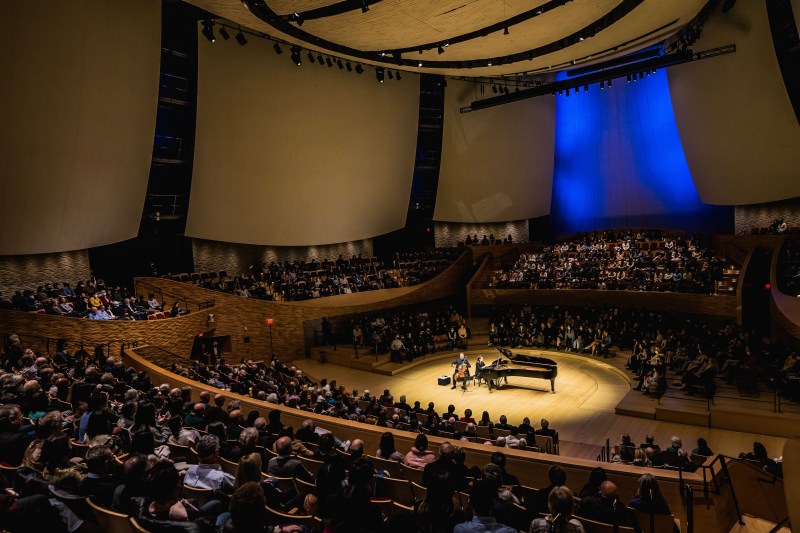Imagine you’ve just finished family dinner when your aunt and uncle, perhaps under peer pressure, announce they’ve got some music to share. With full bellies and fuller hearts, you turn to hear them spin a lifetime of stories into your family’s own personal concert.
With close to 1,000 patrons in attendance, Monday’s Stanford Live concert, featuring celebrated cellist Yo-Yo Ma and renowned pianist Kathryn Stott, might not be described as “personal.” Yet the duo’s heartwarming camaraderie and clever programming felt magnetic in the way we all know music to be: connecting, moving and human. It was like we’d known them all our lives — like an aunt and uncle.
Ma and Stott impressed not with excessive virtuosity, but with effortless balance and ensemble (i.e., playing in sync). Ma sat almost directly behind the piano bench, a position which struck me as strange since it prevented Stott from seeing him. Visual synchronization is typically crucial to chamber music, but the two evidently didn’t need it after half a lifetime of performing together. If that’s what it takes to achieve such a sensitive and flexible sound, then we can only hope to find those musical partners for ourselves in our own lives.
But it’s more than just their apparent Vulcan mind-meld that makes me reach for the “aunt and uncle” analogy: the two really spoke through their instruments. Though they both had sheet music — they’re only human, after all — they played as if pouring organically from their souls.
Ma has a certain way of making you ignore his technique; as my piano teacher once said of Arthur Rubinstein, “his wrong notes sound better than most people’s right ones.” He doesn’t preach with his performance: he stays on the audience’s level, and he pulls the music directly from our hearts.

All of this was displayed most prominently in the concert’s first half, which featured over a dozen short pieces from the early Romantic to the present day. Lush, vibrant and surprisingly homogeneous, this half was Ma’s wheelhouse. Though the pieces ranged from remarkable (modern composer Caroline Shaw’s “Shenandoah”) to unremarkable (Dvorak’s Op. 75, in my opinion), every one felt intentional. These works epitomize the Romantic richness which is the bread and butter of the concert hall, and they made a wonderful start to the evening.
After a lengthy and chatty intermission, the duo resumed with Stott’s shining half of the program. They began with Erollyn Wallen’s “Dervish,” a piece which seeks to capture the essence of the Sufi worship dance of the same name. Though I initially deemed this piece the “hidden spinach in the brownies” of the program, it turned out to be something of a palate cleanser.
What followed was more than 30 minutes of fun in the form of South American music, including works by César Camargo Mariano, Violeta Parra and Astor Piazzolla. Employing extended harmony and syncopated grooves, the tangos were sexy, flashy and clearly the audience’s favorite. Ma rushed a little too much for my taste, but most string players have trouble staying on the back of the beat anyways.
As is customary, the two were immediately shoved into two encores by a near-universal standing ovation (though they didn’t make any ceremony of it, which I thought was nice). The first was “Somewhere Over the Rainbow,” a lullaby to punctuate the night and release the energy from the end of the program. The second was “Almost Like Being in Love,” the award show send-off music that somewhat mitigated the effectiveness of the first encore. Both had the audience on their feet again.
Hopefully, you can see how the program closely mirrored the trajectory of a jovial get-together, from classical standards to slightly drunk dance numbers to end-of-night family favorites. I can’t help but believe this experience was intentional: Ma and Stott’s insistence on holding applause between certain pieces strongly suggests a rigorously pre-planned listening experience. (The two even had boxes to quickly dispose of sheet music in between pieces.) Even if forced, I appreciate the design that goes into a set that has something for everyone.
As a practicing musician, I find that the most memorable concerts rarely depend on their repertoire. More than anything, we remember how music makes us feel, and Yo-Yo Ma and Kathryn Stott did an excellent job at moving their audience. They make me wonder how much of their lives they’ve spent practicing to get their virtuosity and what they’ve experienced to be able to find such emotional musical interpretations. They make music for the audience, not “at” the audience.
Ma said in his opening remarks that Stanford is “one of our favorite places in the world.” For all those not in attendance on Monday, I hope that sentiment brings him back to Bing soon.
Editor’s Note: This article is a review and includes subjective thoughts, opinions and critiques.
